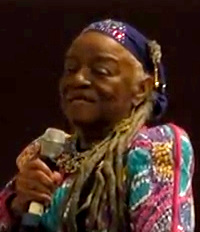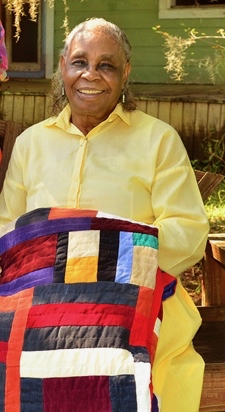Related Research Articles

Judy Chicago is an American feminist artist, art educator, and writer known for her large collaborative art installation pieces about birth and creation images, which examine the role of women in history and culture. During the 1970s, Chicago founded the first feminist art program in the United States at California State University, Fresno which acted as a catalyst for feminist art and art education during the 1970s. Her inclusion in hundreds of publications in various areas of the world showcases her influence in the worldwide art community. Additionally, many of her books have been published in other countries, making her work more accessible to international readers. Chicago's work incorporates a variety of artistic skills, such as needlework, counterbalanced with skills such as welding and pyrotechnics. Chicago's most well known work is The Dinner Party, which is permanently installed in the Elizabeth A. Sackler Center for Feminist Art at the Brooklyn Museum. The Dinner Party celebrates the accomplishments of women throughout history and is widely regarded as the first epic feminist artwork. Other notable art projects by Chicago include International Honor Quilt, Birth Project, Powerplay, and The Holocaust Project. She is represented by Jessica Silverman gallery.

The National Museum of Women in the Arts (NMWA), located in Washington, D.C., is "the first museum in the world solely dedicated" to championing women through the arts. NMWA was incorporated in 1981 by Wallace and Wilhelmina Holladay. Since opening in 1987, the museum has acquired a collection of more than 6,000 works by more than 1,000 artists, ranging from the 16th century to today. The collection includes works by Frida Kahlo, Mary Cassatt, Alma Woodsey Thomas, Élisabeth Louise Vigée-LeBrun, and Amy Sherald. NMWA also holds the only painting by Frida Kahlo in Washington, D.C.

African-American art is a broad term describing visual art created by African Americans. The range of art they have created, and are continuing to create, over more than two centuries is as varied as the artists themselves. Some have drawn on cultural traditions in Africa, and other parts of the world, for inspiration. Others have found inspiration in traditional African-American plastic art forms, including basket weaving, pottery, quilting, woodcarving and painting, all of which are sometimes classified as "handicrafts" or "folk art".

Faith Ringgold is an American painter, painting on different materials including fabric, a published author, mixed media sculptor, performance artist, and intersectional activist, perhaps best known for her narrative quilts.
Quilts of the Underground Railroad describes a controversial belief that quilts were used to communicate information to African slaves about how to escape to freedom via the Underground Railroad. It has been disputed by a number of historians.

The feminist art movement in the United States began in the early 1970s and sought to promote the study, creation, understanding and promotion of women's art. First-generation feminist artists include Judy Chicago, Miriam Schapiro, Suzanne Lacy, Judith Bernstein, Sheila de Bretteville, Mary Beth Edelson, Carolee Schneeman, Rachel Rosenthal, and many other women. They were part of the Feminist art movement in the United States in the early 1970s to develop feminist writing and art. The movement spread quickly through museum protests in both New York and Los Angeles, via an early network called W.E.B. that disseminated news of feminist art activities from 1971 to 1973 in a nationally circulated newsletter, and at conferences such as the West Coast Women's Artists Conference held at California Institute of the Arts and the Conference of Women in the Visual Arts, at the Corcoran School of Art in Washington, D.C..
Cuesta Benberry was an American historian and scholar. Considered to be one of the pioneers of research on quiltmaking in America, she was the pioneer of research on African-American quiltmaking. Her involvement in quilt research spans from founding and participating in various quilt groups to writing articles in renowned quilt magazines and journals. As a quilt scholar, Benberry acquired a collection of important quilts dating from the late 19th century up to the 21st century, as well as an extensive collection of paper documents supplementing quilting exhibitions, books, articles and her personal research.
The Quilt Index is a searchable database for scholars, quilters and educators featuring over 50,000 quilts from documentation projects, museums, libraries, and private collections. It also has quilt-related ephemera and curated essays and lesson plans for teachers.
The Quilt Treasures Project is an oral history project that documents the stories of a number of notable individuals who were instrumental in moving the 20th Century Quilt Revival forward in some significant way. These individuals include:

Queena Stovall was an American folk artist. Sometimes called "The Grandma Moses of Virginia," she is famous for depicting everyday events in the lives of both white and black families in rural settings.
Carolyn L. Mazloomi is an American curator, quilter, author, art historian, and aerospace engineer. She is a strong advocate for presenting and documenting African-American-made quilts. Her own quilts are designed to tell complex stories around African-American heritage and contemporary experiences.

Dindga McCannon, born on July 31, 1947, is an African-American artist, fiber artist, muralist, teacher author and illustrator. She co-founded the collective Where We At, Black Women Artists in 1971.

Jean Ray Laury was an American artist and designer. She was one of the first fine artists to move to quilting as a medium of choice in the late 1950s. Her quilts followed neither traditional method nor pattern; they were bold, modern, colorful collages, often laced with humor and satire. Penning over twenty books and teaching over 2,000 workshops, Laury helped women see the creative possibilities in everyday objects and awake their sense of inspiration. Laury has been called a "foremother of a quilt revival", and "one of the pioneers" of non-traditional quilts.
Alma Lesch was an American fiber artist known for her fiber portraits. She was "the undisputed grande dame of Kentucky textile arts." A historic marker notes her achievements in Shepherdsville, Kentucky where Lesch lived and had her studio. Lesch's quilt, Bathshebas Bedspread, was included in the Objects: USA exhibit in 1969, which was organized by S.C. Johnson and Son.

Mary Lee Bendolph is an American quilt maker of the Gee's Bend Collective from Gee's Bend (Boykin), Alabama. Her work has been influential on subsequent quilters and artists and her quilts have been exhibited in museums and galleries around the country. Bendolph uses fabric from used clothing for quilting in appreciation of the "love and spirit" with old cloth. Bendolph has spent her life in Gee's Bend and has had work featured in the Philadelphia Museum of Art as well as the Minneapolis Institute of Art in Minnesota.
Gwendolyn (Gwen) Ann Magee was an African-American fiber artist. Learning to quilt in the middle of her life, Magee quickly became known in the world of fiber art for her abstract and narrative quilts depicting the African-American experience. Her work can be found in the permanent collections of the Mississippi Museum of Art, the Museum of Mississippi History, the Michigan State University Museum, and the Renwick Gallery of the Smithsonian Museum of American Art, and has been exhibited internationally.

NedRa Bonds is an American quilter, activist, and retired teacher, born and raised in the historic Quindaro neighborhood in Kansas City, Kansas. Bonds creates quilts and mixed media fiber dolls using fabric, beads, and symbolism to explore issues dealing with human rights, race, women, politics, and the environment. She is best known for her Quindaro Quilt, a quilt measuring 4 by 6 feet, detailing the important history of the Quindaro neighborhood and its role as part of the National Underground Railroad System of Historic Trails. As a community activist and educator, Bonds advocates for legislation, taught workshops locally and internationally, and attended the Earth Summit Conference on Environment and Development of the United Nations as a delegate in Rio de Janeiro, Brazil, in 1992. Bonds is a practicing artist and retired teacher in Kansas City, Kansas. Her recent projects include her Common Threads quilt, commissioned by the Kansas City Chiefs for their Arrowhead Arts Collection, the Wak’ó Mujeres Phụ nữ Women Mural collaboration, sponsored by the Charlotte Street Foundation's Rocket Grant Program, in Lawrence, Kansas, and her recent cancer project. Bonds was appointed to the Kansas Arts Commission by Kansas Governor Joan Finney in 1992.
Chawne Monique Kimber is an African-American mathematician and quilter, known for expressing her political activism in her quilts. She was a professor at Lafayette College, where she headed the department of mathematics. Kimber is now the Dean of the College at Washington and Lee University.
Joan Schulze is an American artist, lecturer, and poet. Schulze's career spans over five decades: she is best known for her work of contemporary quilts, fiberarts, and collage. Schulze has been named a “pioneer of the art quilt movement,” and her influence has been compared to that of Robert Rauschenberg’s. Her work is in galleries and private collections worldwide including the Renwick Gallery/Smithsonian Institution in Washington DC, the Museum of Arts and Design in New York, & the Oakland Museum of California.

Gwen Marston née Gwendolyn Joy Miller was an American quilter, quilt teacher, lecturer, and author who championed a style of quilting she called liberated quiltmaking. She encouraged modern quilt makers to break away from using commercial quilt patterns and to learn to design their own unique pieces of art.
References
- ↑ "Shelly Zegart Quilts, Etc". www.shellyquilts.com. Retrieved 2020-01-23.
- ↑ "Shelly Zegart | Folkstreams". www.folkstreams.net. Retrieved 2020-01-23.
- ↑ the Kentucky Quilt Project. "Why Quilts Matter" (PDF). Why Quilts Matters. Retrieved December 13, 2017.
- ↑ "Why Quilts Matter: History, Art & Politics - Interview: Shelly Zegart for LEO". www.whyquiltsmatter.org. Retrieved 2017-12-13.
- ↑ Zoellner, Andrew. "Q&A: Shelly Zegart, Why Quilts Matter". Craft Council. Retrieved December 13, 2017.